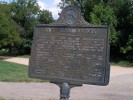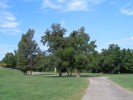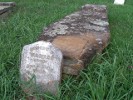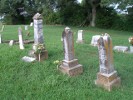Carrollton, AR - Carroll County
"Carrollton is located in the fertile valley of Long Creek, snugly nestled among forested hills that add beauty and charm to its setting." ~ Steele T. Kennedy, 1959History of Carrollton
Early Pioneers of Carrollton and Carroll County
Carrollton was an early Carroll County town in the valley of Long Creek that served as the first county government seat. Like the county, the town was named for the American revolutionary Charles Carroll of Carrollton, an original signer of the Declaration of Independence. The settlement originated as an early trading post in 1823 or 1824, with a water mill constructed several miles north of town (near Alpena) by an early homesteader named Bruce Boyd. Other early settlers in the area included the See Family, as well as the Sneeds. Charles Sneed, a native of Kentucky born about 1801, married Jane Coker in 1824, and would serve in 1833 as the postmaster at the "Liberty" Post Office, which was moved to Carrollton on January 15, 1834. He was also the Carroll County Sheriff from 1836 to 1842, and he constructed the first road to traverse the county. Known as the "Dubuque Road", it ran from the early town of Dubuque along an old Indian trail to Fort Smith.
The area was first settled by James Jones, who had relocated to Carroll County in 1833. Within three years, a preacher and Methodist minister named Henderson Lafferty had settled nearby and convinced Jones to sell his title of roughly 80 acres. Lafferty then sold this land to the commissioners charged with establishing the new county seat for $1,000. The three county commissioners, Henry Keys, John S. Blair, and Barnett Cheatham soon set out to establish the new town site, hiring a gentleman named Dr. Sanders to survey the land and detail a townsite plat with a central public square. Surrounding the public square, individual building lots were to be sold for $25 each.
Established on July 29, 1834, the post office in Carrollton was actually moved to the town from its original location in Liberty, roughly 30 miles away on the White River. Some of the first lot owners in town included John Blair, William C. Mitchell, H.L. Denton, and the aforementioned Henderson Lafferty, who would soon become the town's first merchant. H.L. and Tilford Denton soon formed a Company of their own, and the first attorney in the county, A.M. Wilson, had an office in Carrollton as early as 1836. Built in 1837, the first courthouse was a two story, 20-foot square log structure located just south of the public square. Early church services were also held in this building. Two years later, the Cumberland Presbyterian Church was formed with Revs. Pearson and Buchannon. A Missionary Baptist Church was also established, with Rev. Bartlett serving as Pastor.
The Law Comes to Carrollton
By the Spring of 1839, the lawless county was forced to form a band of armed citizens to police a group of thieves and half-breed Cherokee "miscreants" living nearby. This early group of self-appointed peace keepers, consisting of 20 to 30 men led by Captain Thomas A. Clark, was known as the Carroll County Regulators. After convincing most of the criminals to leave the area, the group disbanded and two companies of the Carroll County Militia were organized under the commands of W.C. Mitchell and Tilford Denton. In 1840, James C. Chaney of Osage was hired to construct the first county jail, a sturdy log building with 12" thick timber floors and ceilings, triple thick first floor log walls, and heavy doors hung on massive iron hinges. It was about 22 feet square and two stories tall, like the courthouse.
Early Development
By 1840, the first log school house had been constructed, and several additional stores had opened, including those operated by early lot owners John and Joel Blair, and Henry Keys. The town boasted three good springs for their drinking water, some of which was carried directly to the town square via bored wooden timbers. The channeled springs would then empty into a wooden trough, and citizens would come with buckets as they needed water. This early system built by Bennett S. Kirkpatrick, W.H. Kirkpatrick, and Ike Wann, was later replaced with metal pipe upon the arrival of a canning factory - a costly investment none-the-less, particularly when local moonshiners kept stealing lengths of pipe!
In 1845, the temporary log courthouse had been replaced by a larger permanent brick structure in the center of the public square. This two-story building, constructed by Louis Rains and William Young for about $3,000, was about 30 by 40 feet square and featured a courtroom on the lower level, with jury rooms and clerk office upstairs. Just before the Civil War, Carrollton was a thriving small town with its own mill, courthouse and log jail. Four large mercantile stores and two multi-story hotels supplemented the numerous private residences in the area by 1857. But by the end of the Civil War, all that remained of Carrollton was a springhouse and a couple of stables.
Carrollton in the Civil War
Most of the citizens of Carrollton were Confederate sympathizers during the Civil War, though the area saw visiting encampments from both sides. The First Arkansas Cavalry was mustered there in 1862, and Carrollton served as a military training center for two Confederate battalions. This group of soldiers later fought at Poison Springs, lost 14 men at the Battle of Prairie Grove, and several more at Marks Mill. 3,000 troops under General Blount also camped at Carrollton, and a skirmish occurred near Carrollton Cemetery on August 14, 1864. Federal Army General Herron also positioned his battalion of approximately 20,000 men just north of Carrollton at one point during the war. Though much of the town fell victim to fires during the war, county clerk Sam Peel had the foresight to hide the county records within nearby cemetery vaults. If he hadn't, they would have likely burned just like the earlier county records had when the first Carroll County courthouse in Carrollton fell victim to arson.
Post-War Carrollton, AR
After the Civil War, the town began to rebuild. A blacksmith from Tennessee named Ike Wann built the first house after the war in 1866, and also opened a blacksmith shop. Missouri merchant Edward Norris opened the first store after the war, and Crump & Berry's shop soon followed. Rebuilding the courthouse was a top priority, and the new building was nearly completed when it was burned to the ground yet again. Local legend states that this fire was started by a group of cold-blooded killers, in an attempt to destroy county records that led to their prosecution for the death of several Missouri cattlemen. Whether there is any truth to the story or not, many of the county records that Sam Peel had protected during the war were lost to this fire. The former store owned by Crump & Berry was then sold to the town and moved to the center of the public square to be used as the third and final brick courthouse building.
Carrollton Loses its County Seat
In 1869, a large portion of land was carved out of Carroll County for the formation of Boone County, leaving Carrollton near the edge of the county. The addition of Clifty and Cedar Townships to Carroll County further distanced Carrollton from the overall population. After some political struggling, the county seat was eventually removed to Berryville in 1875. This didn't stop W.S. Tilton and E.R. Marvin from making Carrollton the headquarters of the first newspaper, the Carroll County Bowlder, in the county in November of 1875. They would continue to publish it from Carrollton for about two years before relocating it to Berryville. Carrollton was officially incorporated on February 7, 1876 but it would never regain its status as an important political center. The courthouse building fell into disuse by 1880.
Growth and Education
Although its political prominence had reached its peak, the town continued to attract new business for some time. The Cincinnati Mills opened there on June 12, 1883, with an operating grain mill, saw mill, and cotton gin. A flour mill, church and seminary also called Carrollton home. By 1890, the town boasted several general stores, hotels, a drugstore, hardware store, and a brand new school building for the Carrollton Academy, which had previously been hosting classes at the Masonic Lodge. The large, two-story dedicated school structure built near the public square quickly established Carrollton Academy as a county-wide educational center. Built by Blaylock on land donated by Abe Crockett and blacksmith Ike Wann, parents would send their children from distant towns to board in local Carrollton residences and attend the prominent academic institution. Major Belding was also a very well-respected instructor in the county.
Although extremely popular, Carrollton Academy didn't hold a monopoly on specialized county education for long, and before the turn of the century, the academy had closed its doors. Then in December of 1899, Austin and Henry Davis arrived in Carrollton and reopened the academy with only 15 pupils.
Carrollton Organizations
The Masonic Lodge was established in Carrollton on November 10, 1853, and was known as "Yell Lodge #64". The original lodge hall building was built in 1876, and is a two-story frame structure measuring about 50 by 35 feet. After the railroad came to Eastern Carroll County in 1901, the Carrollton Lodge was consolidated with a new Masonic Lodge in Green Forest, but the name was retained (Yell Lodge #64). The Independent Order of Odd Fellows (I.O.O.F) Lodge # 425 in Carrollton was instituted on May 26, 1906. It was consolidated with Alpena I.O.O.F. Lodge #440 on April 20, 1920.
Decline
The town slowly declined over time mostly due to its loss of county seat, and the fact that it was bypassed by the railroad in 1901. When the railroad depot was established in nearby Alpena, much of the local business went along with it. The Carrollton Post Office closed on September 30, 1922. The old Carrollton Academy building was razed and rebuilt in 1946. In the 1950's, the town still contained a small store, about a dozen residences, an abandoned canning factory and lodge house, and an old two-room stone school house.
Carrollton as a State Park
The Carroll County Historical Society was instrumental in having a historical marker installed in Carrollton, and they also worked on having the area classified as a State Park. At the urging of the Historical Society, a bill was introduced by Rep. F.A. Teague to gain State Park status, and in 1959 the bill was passed by House and Senate, adding Carrollton to the Arkansas State Park system. Park plans called for picnic tables, BBQ grilles, historical markers and waste containers, and CCHS hoped to restore the town square, stables, and the town hall. However, for the area to become an actual park, land would need to be procured and deeded to the state. As of 1960, about $5000 had been earmarked for the park, but there was some newspaper pushback stating that funds would be better served at larger parks. In 1962, the Masonic Lodge was rebuilt by the Arkansas Parks and Publicity Commission. A Mountain Meadows Massacre memorial has also been constructed.
Carrollton Today
Not much remains of this early Carroll County settlement today, aside from a few scattered homes, the cemetery, a historical marker, the rebuilt Masonic Lodge House, and the monument to memorialize the victims of the Mountain Meadows Massacre. The Carrollton Cemetery is said to be the oldest in the county, with stones dating back to 1812. The Trail of Tears crossed through the area, and the Shawnee Indians reportedly had a village to the south. It is hard to believe that the town once acted as an important stage coach stop, cotton and milling center, and the definitive social and political epicenter for the county, featuring its own doctors, attorney, newspaper, blacksmith, livery stables, apothecaries, churches, hostelry, cotton gin, flour mill, grist mill, grade school, high school, academy, multiple stores and hotels, a courthouse, town square, and jail.
« Click here for sourcesCommunities of Carroll County:
|












